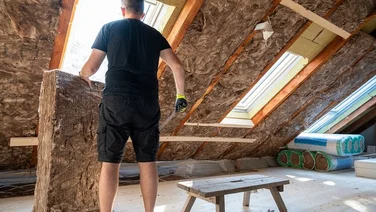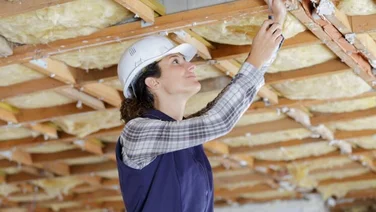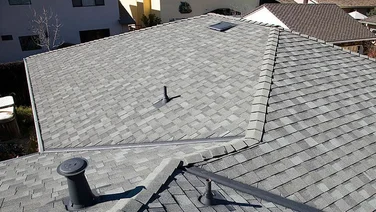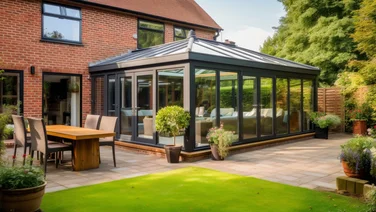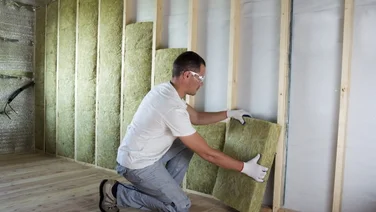There are many types of insulation, such as spray foam insulation or solid wall insulation. All of them can be good options depending on your property and budget.
Properly insulating your home is one the best ways to keep your energy bills down, because it stops heat leaking out, but every home’s insulation needs are different.
Our guide on the best types of insulation will help give you a clearer picture of what you need.
If you’re ready to start looking for insulation, spray foam insulation is a great option for its versatility and high thermal performance. To get quotes for spray foam insulation, just fill in a few details here and our trusted suppliers will get back to you with quotes to compare.
Get free insulation quotes
Answer a few quick questions, and our trusted installers will send you bespoke insulation quotes – for free.

What’s the best material for insulating your home?
A one-size-fits-all approach won’t find you the best material for insulating your home, because every home is different.
It’s better instead to work out what type of insulation will work best for your home’s unique circumstances.
For example, if your home has no wall insulation then it’s probably best to start there, because walls account for the most heat loss in a property — 35–40%.
Or, if you live in a semi-detached house with no roof insulation, then choosing spray foam insulation is a great option.
Here are the best insulation options for you to consider.

Cavity wall insulation
If your home is built with cavity walls, then we highly recommend cavity insulation. A cavity wall is where there is a gap between two typically brick layers.
Getting cavity insulation in a semi-detached house costs around £1,200, and can save you up to £305 each year, meaning you’ll break even in just four years.
There are also lots of eco-friendly types of insulation that you can use. The three main types of materials used in cavity wall insulation are:
- Blown mineral fibre — strands of fibreglass or mineral wool that are forced into the cavity using compressed air
- Polystyrene beads or granules — these beads are either held together with resin, or installed loosely
- Urea formaldehyde foam — this foam is injected into the cavity where it then expands to fill the gap
Key benefits
- Reduces the risks of moisture buildup
- Improves sound isolation
- Adds fire resistance
Key disadvantages
- Requires a professional to install
- Gaps in the insulation can cause cold spots, increasing the chance of condensation
Solid wall insulation
Homes built in the UK before 1920 likely have solid walls — which covers 28% of properties.
You can get solid wall insulation on the inside or the outside of your walls, and the method used depends on which of these you pick.
Inside insulation typically requires sticking rigid insulation boards to your wall, covered by plasterboard to make sure it still looks presentable.
Outside insulation involves installing a layer of insulating material to the wall, before attaching render or cladding. A finish is then applied to improve the appearance.
You can save up to £390 per year with solid wall insulation, but the upfront cost is high — around £14,000 for external walls and £10,000 for internal walls.
External wall insulation is one of two options for solid walls. You can read more about the pros and cons of external wall insulation on our page.
Key benefits
- Improves sound insulation
- Helps reduce heat loss by up to 60%
- Can stop you releasing around 0.9 tonnes of CO2 per year
Key disadvantages
- Internal solid wall insulation reduces a room’s size by around four inches
- More expensive than cavity wall insulation
Spray foam loft insulation
Spray foam insulation is an excellent alternative to fibreglass, especially as fibreglass is well-known for causing skin, throat, and eye irritation.
It insulates a home up to 2.7 times more effectively than fibreglass, and it can reach areas other forms of insulation can’t.
That’s because spray foam expands when it’s applied, so you can fill in those hard-to-reach places, and the chemical reaction will do the rest.
Spray foam lasts a lifetime too — expect it to remain effective for 80–100 years. It’s the ultimate fire-and-forget solution to insulating your home.
If you want to get quotes for spray foam insulation, why not fill in our simple form? Once you’ve entered in a few details, we’ll put you in touch with our trusted suppliers and they’ll get back to you with prices for you to compare.
Key benefits
- More flexible than other forms of insulation
- Effective at keeping allergens and other airborne contaminants out of your home
- Reduces heat loss by up to 50%
Key disadvantages
- Very difficult to remove once installed
- Can impact property price
- Can’t be used in listed properties
- Not a DIY job
Pipe insulation
Pipe insulation is a foam tube that is wrapped around the pipes carrying hot water from your boiler to your hot water tank.
It’s an essential way to reduce heat loss — which in turn helps lower your energy bills and stops your pipes from freezing in cold weather. By keeping your water warm for longer, you’ll use your boiler less.
The best part of pipe insulation is you can install it yourself, with no need to hire a professional. All you need to do is buy the material, measure the pipes, and fit it around them.
It’ll only save you £3 per year, according to the Energy Saving Trust (EST). But at just £1.75 per metre of pipe insulation and around £20 to cover all main pipes, it’s still well worth it.
Key benefits
- Reduces heat loss
- Stopes pipes freezing in winter
- Avoids build-up of condensation
Key disadvantages
- Can be tricky to install retroactively
- Doesn’t cut energy bills by much
Floor insulation
The floor is responsible for around 15% of the average home’s heat loss, making insulating it a wise choice. This type of insulation works by creating an insulating layer between your floorboards and the floor joists.
It helps stop heat leaking through any tiny gaps too, which can often be difficult to isolate otherwise. You’ll save around £75 a year too.
When you install floor insulation, it’s important to make sure you deal with any rot or damp underneath the floorboards before you start. Otherwise, the insulation could trap this moisture, which can cause damage to your floor.
The materials used in floor insulation are:
- Insulation boards/EPS sheets — these sturdy, crack-resistant boards are a good choice, and they’re waterproof
- Spray foam — just like using spray foam in your roof, using it to insulate your floor provides you with excellent heat retention
- Cork, wood, or cellulose — not the most effective way to insulate your floor, but it is very cheap and can be used with other materials to boost efficiency
Because the materials vary, so does the cost. The table below shows the average prices of floor insulation by property type, according to the National Insulation Association.
Which type of insulation is best for you?
The best type of insulation depends on your home’s circumstances. Work out what areas of your home do and don’t have insulation first, and prioritise accordingly.
If you don’t have any insulation at all, a good rule of thumb is to look at what parts of your home lose the most heat, and then add insulation in descending order.
35–40% of your heat loss leaks out through your walls, so this should be your priority. If you have solid walls however, the cost can climb high.
Roofs account for around 25% of a home’s heat loss, making it the second-most important part of a home to insulate. Roof insulation is cheaper than solid-wall insulation, too.
Roughly 15% of your heat loss will go through your home’s floors, and because costs aren’t prohibitive, it’s definitely worth considering.
Finally, windows account for nearly 20% of heat loss in a property, which makes getting double glazing a smart decision.
Summary
In light of rising energy costs, insulating your home has taken on an important role in helping you save money on your bills. If the price cap rises to £3,244 in October 2022, as is expected, insulation will save you even more money.
One type of insulation we recommend is spray foam insulation, because of its high thermal performance and ability to insulate different areas of your home — including roofs, walls, and floors.
Want to see how much spray foam insulation would cost for your home? Simply enter a few details here, and our trusted suppliers will be in touch with free quotes.

